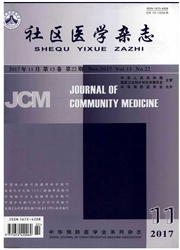

 中文摘要:
中文摘要:
目的探讨深圳市大工业区蚊虫密度与气象因素的关系,为有效监控蚊虫密度及蚊媒传染病提供科学依据。方法对深圳市大工业区2011一2013年监测的蚊虫密度资料与同期的降水量、平均气温、最高气温等气象数据资料进行相关性及多元逐步回归分析,P〈0.05为差异有统计学意义。结果2011—2013年蚊虫密度与同期的降水量、最高气温、平均气温、最低气温、平均相对湿度、最小相对湿度、雨日、雷暴日等呈显著正相关(r:=0.456、0.537、0.555、0.517、0.535、0.485、0.510、0.491,均P〈0.05);而与霾和大雾日呈负相关(r=一0.420、一0.378,均P〈0.05)。平均温度和平均相对湿度进入回归模型(t=2.510、2.333,均P〈0.05)。结论影响深圳市大工业区蚊虫密度的主要气象因素为平均气温和平均相对湿度,其中平均气温对蚊虫密度的影响最大,平均相对湿度次之。
 英文摘要:
英文摘要:
Objective To provide scientific basics in the effective monitoring of mosquito density and vector-borned diseases,dis- cussing the relationship between mosquito density and meteorological factors, in Shenzhen export processing zane.Methods With the data of mosquito density from 2011 to 2013 and the data of homochronous meteorological factors such as precipitation,average temperature,hightest temperature,lowest temperature,sunshine time,average relative humidity,minimum relative humidity,spearman's rank correlation and multiple stepwise regression were established,P〈0.05 was considered statistically significant.Restflts The relation between mosquito density and precipitation,hightest temperature,average temperature,lowest temperature,average relative humidity,minimum relative humidity,rainy days,thunderstorm days were positively correlated(r=0.456,0.537,0.555,0.517,0.535,0.485, 0.510,0.491,all P〈0.05),while was negatively correlated between mosquito density and haze days,heavy fog days(r=-0.420,-0.378, all P〈0.05).The multiple stepwise regression equation average temperature and average relative humidity(t=2.510,2.333,all P〈0.05). Conclusion Average temperature and average relative humidity were the main meteorological factors which effected the mosquito density in Shenzhen export processing zone,the affective degree form high to low is average temperature and average rel- ative humidity,respectively.
 同期刊论文项目
同期刊论文项目
 同项目期刊论文
同项目期刊论文
 期刊信息
期刊信息
